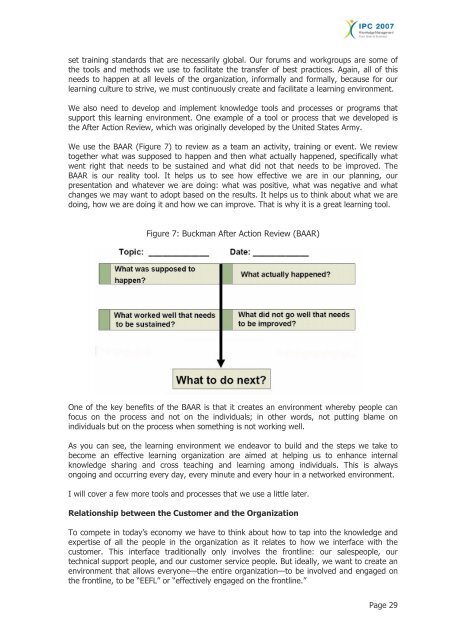Knowledge Management: From Brain to Business (PDF 5.5 - Asian ...
Knowledge Management: From Brain to Business (PDF 5.5 - Asian ...
Knowledge Management: From Brain to Business (PDF 5.5 - Asian ...
Create successful ePaper yourself
Turn your PDF publications into a flip-book with our unique Google optimized e-Paper software.
set training standards that are necessarily global. Our forums and workgroups are some of<br />
the <strong>to</strong>ols and methods we use <strong>to</strong> facilitate the transfer of best practices. Again, all of this<br />
needs <strong>to</strong> happen at all levels of the organization, informally and formally, because for our<br />
learning culture <strong>to</strong> strive, we must continuously create and facilitate a learning environment.<br />
We also need <strong>to</strong> develop and implement knowledge <strong>to</strong>ols and processes or programs that<br />
support this learning environment. One example of a <strong>to</strong>ol or process that we developed is<br />
the After Action Review, which was originally developed by the United States Army.<br />
We use the BAAR (Figure 7) <strong>to</strong> review as a team an activity, training or event. We review<br />
<strong>to</strong>gether what was supposed <strong>to</strong> happen and then what actually happened, specifically what<br />
went right that needs <strong>to</strong> be sustained and what did not that needs <strong>to</strong> be improved. The<br />
BAAR is our reality <strong>to</strong>ol. It helps us <strong>to</strong> see how effective we are in our planning, our<br />
presentation and whatever we are doing: what was positive, what was negative and what<br />
changes we may want <strong>to</strong> adopt based on the results. It helps us <strong>to</strong> think about what we are<br />
doing, how we are doing it and how we can improve. That is why it is a great learning <strong>to</strong>ol.<br />
Figure 7: Buckman After Action Review (BAAR)<br />
One of the key benefits of the BAAR is that it creates an environment whereby people can<br />
focus on the process and not on the individuals; in other words, not putting blame on<br />
individuals but on the process when something is not working well.<br />
As you can see, the learning environment we endeavor <strong>to</strong> build and the steps we take <strong>to</strong><br />
become an effective learning organization are aimed at helping us <strong>to</strong> enhance internal<br />
knowledge sharing and cross teaching and learning among individuals. This is always<br />
ongoing and occurring every day, every minute and every hour in a networked environment.<br />
I will cover a few more <strong>to</strong>ols and processes that we use a little later.<br />
Relationship between the Cus<strong>to</strong>mer and the Organization<br />
To compete in <strong>to</strong>day’s economy we have <strong>to</strong> think about how <strong>to</strong> tap in<strong>to</strong> the knowledge and<br />
expertise of all the people in the organization as it relates <strong>to</strong> how we interface with the<br />
cus<strong>to</strong>mer. This interface traditionally only involves the frontline: our salespeople, our<br />
technical support people, and our cus<strong>to</strong>mer service people. But ideally, we want <strong>to</strong> create an<br />
environment that allows everyone—the entire organization—<strong>to</strong> be involved and engaged on<br />
the frontline, <strong>to</strong> be “EEFL” or “effectively engaged on the frontline.”<br />
Page 29
















